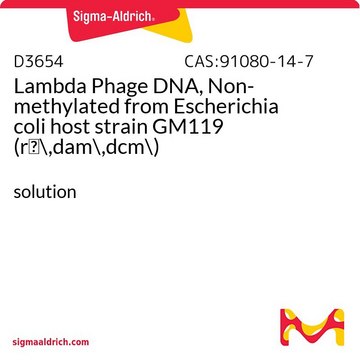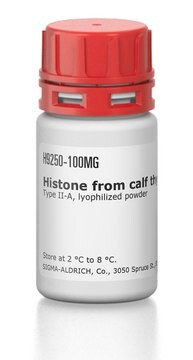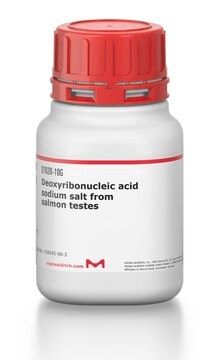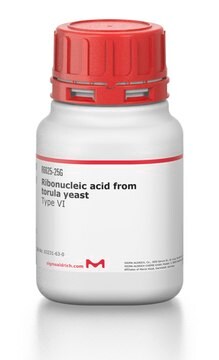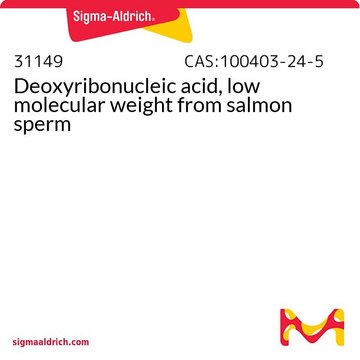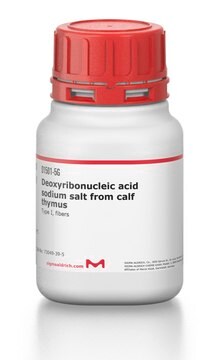D9768
Lambda Phage DNA, Methylated from Escherichia coli host strain W3110
lyophilized powder
Faça loginpara ver os preços organizacionais e de contrato
About This Item
Produtos recomendados
grau
Molecular Biology
for molecular biology
Formulário
lyophilized powder
peso molecular
31.5 × 103 kDa
48 kb
adequação
suitable for substrate for restriction endonucleases
temperatura de armazenamento
2-8°C
Procurando produtos similares? Visita Guia de comparação de produtos
Descrição geral
Phage DNA is isolated from infected E. coli, passed through a series of enzymatic steps before final phenol-chloroform extraction. This methylated lambda DNA is partially cleaved by Bcl I, Cla I, Mbo I, Mbo II, Taq I and Xba I.
Especificidade
Unique restriction sites: Apa I,Nae I, Nar I, Nhe I, PaeR7 I, SnaB I, Xba I and Xho I. Methylated lambda is partially cleaved by Bcl I, Cla I, Mbo I, Mbo II, Taq I and Xba I.
Aplicação
Lambda Phage DNA, Methylated from Escherichia coli host strain W3110 has been used in DNA combing to determine the conversion factor.
Lambda Phage DNA, Methylated from Escherichia coli host strain W3110 is suitable for use as a substrate for restriction enzymes. It was used for immunoprecipitation in ChIP assays.
The lambda phage has an icosahedral head and a long tail terminating in a single fiber. At both ends of the 5′ termini are complementary 12-nucleotide single strand sequences that contribute to the cohesive ends (cos region) of the DNA. The tail of the phage latches on the host outer membrane receptor and injects phage DNA into the cell. The phage converts the E. coli to a lysogenic state in which the phage functions are repressed and the phage genome may remain dormant (prophage) for a long time. This property is seen in bacteriophages that carry CII and CIII genes that are responsible for CI expression. Bacteriophages with CI mutation in the CI gene are able to maintain a lysogenic state at defined temperatures.
Infecting E. coli strain W3110 with lambda C1857 strain creates E. coli lysogen cultures. The phage is released from E. coli cell pellets by lysing with a high salt buffer, pH 8.0. The crude mixture is passed through a series of enzymatic steps, multiple cesium gradients, and phage DNA is dialyzed against 1 mM Tris-HCl, pH 8.0, and 1 mM magnesium chloride. The DNA is finally extracted by phenol-chloroform solution.
Infecting E. coli strain W3110 with lambda C1857 strain creates E. coli lysogen cultures. The phage is released from E. coli cell pellets by lysing with a high salt buffer, pH 8.0. The crude mixture is passed through a series of enzymatic steps, multiple cesium gradients, and phage DNA is dialyzed against 1 mM Tris-HCl, pH 8.0, and 1 mM magnesium chloride. The DNA is finally extracted by phenol-chloroform solution.
Definição da unidade
One O.D. (A260) is approximately 50 μg of DNA
Reconstituição
Add the appropriate amount of 1x Tris-EDTA buffer, pH 8.0 (Product No. T9285, diluted to 1x, or comparable), to the vial.
Incubate the DNA sample vial at 65 °C for 4 hrs with frequent mixing.
After reconstitution, the product should be stored at -20 °C.
Incubate the DNA sample vial at 65 °C for 4 hrs with frequent mixing.
After reconstitution, the product should be stored at -20 °C.
produto relacionado
Código de classe de armazenamento
11 - Combustible Solids
Classe de risco de água (WGK)
WGK 3
Ponto de fulgor (°F)
Not applicable
Ponto de fulgor (°C)
Not applicable
Equipamento de proteção individual
Eyeshields, Gloves, type N95 (US)
Escolha uma das versões mais recentes:
Já possui este produto?
Encontre a documentação dos produtos que você adquiriu recentemente na biblioteca de documentos.
Os clientes também visualizaram
Analysis of replicating yeast chromosomes by DNA combing
Gallo D,et al.
Cold Spring Harbor Protocols, 2016(2), pdb-prot085118 (2016)
P Tran et al.
Physical review letters, 85(7), 1564-1567 (2000-09-06)
We have measured the conductivity sigma along the lambda phage DNA (lambda-DNA) double helix at microwave frequencies using lyophilized DNA in and also without a buffer. The conductivity is strongly temperature dependent around room temperature with a crossover to a
Alec M Desimone et al.
Molecular and cellular biology, 30(13), 3342-3356 (2010-05-05)
Switching between alternate states of gene transcription is fundamental to a multitude of cellular regulatory pathways, including those that govern differentiation. In spite of the progress in our understanding of such transitions in gene activity, a major unanswered question is
Nossa equipe de cientistas tem experiência em todas as áreas de pesquisa, incluindo Life Sciences, ciência de materiais, síntese química, cromatografia, química analítica e muitas outras.
Entre em contato com a assistência técnica
